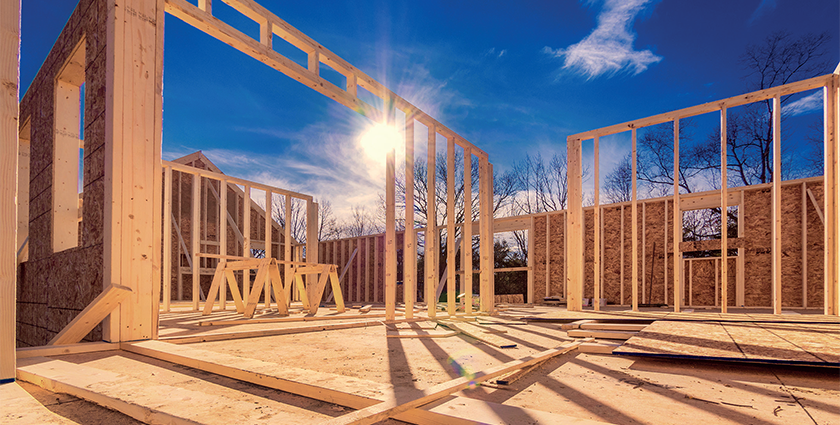
Shifting attitudes
The UK and US are closely connected and notoriously share a number of similarities and differences across the board. When it comes to housing, both have fast growing populations, meaning housing is in high demand and short supply. According to research from Realtor.com, the US is short 5.24 million homes, representing an increase of 1.4 million from the 2019 gap of 3.84 million. In the UK, the new housing supply is currently lower than the government’s ambition of 300,000 new homes per year, and its busy urban cities are where the majority of the shortages lie. The government has recorded that 216,000 new homes were supplied in 2020/21, leaving us with an 84,000 home shortfall.
The past two years have been hugely trying for the construction industry worldwide. The impact of the pandemic has seen a spike in shipping delays and huge materials shortages too. Now, building on both sides of the pond is on the rise, as respective construction industries work hard to close the gaps widened by the pandemic.
Timber triumphs
As we hone in on the differences in construction methods between the UK and US, it’s clear the choice of material is a key variant. Time magazine reports the US is ‘stubbornly attached to timber’ and it’s one of the few places in the world where wood is the dominant material used in new-home construction. Around 90 percent of homes built in 2019 were wood-framed, according to the National Association of Home Builders.
The science supports this building method, thanks to wood’s sustainable benefits and the need for reduced carbon emissions, with studies finding wooden homes to emit 69 percent less than concrete ones.
At Zeroignition, we’re huge advocates for timber construction. However, reports, such as UK Housing: Fit for the future, highlight there are barriers preventing our construction industry incorporating wood into our building projects. Why? Well, primarily a lack of education surrounding the use of timber materials in construction. The sheer amount of forward-planning required to create a robust supply chain to facilitate the needs of the UK’s construction industry is also an issue. For me, however, the psychological barrier that “wood burns so it must be dangerous” is the real blocker.
This thinking isn’t commonly applied to the key materials, like steel and concrete, commonly favored by the UK. While there’s no denying fire is a devastating force, and unprotected timber does burn, steel does melt, and concrete does degrade in a fire.
Ultimately, these long-standing misconceptions around fire performance have held timber back from being used as a realistic alternative to concrete or steel in the UK. It’s time these were addressed head-on.
Pros and cons
As a trans-Atlantic business, we work closely with both UK and USA businesses, and many of our experts have insights into the key differences in their building techniques. So with their help, I will explore the pros and cons of building processes in the US, in relation to the UK.
First, it’s worth noting that you rarely hear complaints about the quality of the construction in the US, this is because of a very detailed building code and tight enforcement at the municipal level. Construction costs are relatively low compared to the historic cost of land. There have been some issues, one example was a leaky condominium problem in the Pacific Northwest in the 80s and 90s, but for the most part this has been fixed, or new technologies have been developed to combat the issue.
Far more common are complaints regarding the time it takes for permits and variances to be approved by municipalities, which in some cases add to the overall cost of the project. This then puts a limit on the ultimate affordability of the finished housing. Taking this one step further, although there is a perceived lack of affordability in the US, when those prices are represented in the UK, our North American colleagues were astounded by how much we pay for such little space. Our building methods cause this, as well as the fact that we’re an island state with very limited availability of land.
Looking at the positives, the dominant construction materials (wood, cement, composites) commonly used in US are readily available at competitive prices. US building styles change often and the products used adapt easily to changing consumer tastes. Municipalities respond to existential threats like forest fires by developing new building codes that feature rules for hardened homes.
Then there’s the inarguable factor of geography. Our experts stress that while building with brick like we do in the UK is nice, availability and building knowledge is a real challenge. The US is earthquake aware and there is a strong belief that brick is not seismic-friendly, whereas wood has flex and stands a much better chance of withstanding tremors.
Certification is king
With the continuing innovation in building materials and approaches, it’s time to look at certification once more. All construction materials need to be have been fully tested for thermal, acoustic, fire, airtightness and environmental certifications.
This process needs to be properly certified through a third party regulator, rather than being self-certified. Marking your own homework, which is completely legal in the current climate, could lead to potential disaster.
The fast pace of innovation means statutory accreditation of materials, and an enhanced inspection regime need to be top of the industry’s agenda. With proper engineering design, correct material choice and effective installation, and a robust inspection regime, timber construction can be as fire-safe as concrete and steel options. Furthermore, while it is a combustible material, mass timber can provide the necessary two-hour window required for fire protection due to its slow rate of charring.
So, what’s the outcome?
Ultimately, both countries have their own methods which have evolved over centuries, and new ideas take time to infiltrate. As it stands, the UK thinks building with wood is a risk because it burns and it doesn’t last, yet the US avoid building with brick because it’s expensive and doesn’t flex at all, so doesn’t suit their topography.
Making significant changes to this deeply ingrained thinking may take generations to adopt. Yet from our perspective, the faster we can work to change the UK’s negative perceptions of wood the better. As it stands, it’s the environment that’s paying, and in turn the generations that will come after us. Ironically, I believe that over time, the benefits of building with wood will be made known, and the ingrained idea that we have to build a certain way could potentially be forgotten.
It is a continuing innovation in building materials and approaches, as well as a firm focus on robust certification, which will help shift attitudes. All construction materials need to have been fully tested for thermal, acoustic, fire, airtightness and environmental certifications.
The fast pace of innovation to help rectify harm to the planet needs statutory accreditation of all materials and an enhanced inspection regime. This will ensure the UK is confident to follow the US-lead and build using sustainable materials, with peace of mind that they’re truly certified and fit for purpose.
For a list of the sources used in this article, please contact the editor
 Ian King is COO at Zeroignition (Zi), the only fire-focused chemical technology company solely dedicated to tailoring chemistry to enable the production of non-toxic, highly effective fire-retardant products. It supplies manufacturers of construction products worldwide who are committed to meeting and beating fire safety requirements, and rapidly innovating their product ranges to satisfy new markets.
Ian King is COO at Zeroignition (Zi), the only fire-focused chemical technology company solely dedicated to tailoring chemistry to enable the production of non-toxic, highly effective fire-retardant products. It supplies manufacturers of construction products worldwide who are committed to meeting and beating fire safety requirements, and rapidly innovating their product ranges to satisfy new markets.
In an era where the risks and devastation caused by fire are front page news, Zi offers technical solutions that are bespoke and integrated into manufacturing to provide a unique response to the challenge.
Founded in 2009, Zeroignition Group is a privately held group of companies with a Head Office in Canada, and R&D and production facilities across Europe and in North America.
Build safe.
Save lives.
www.zeroignition.com